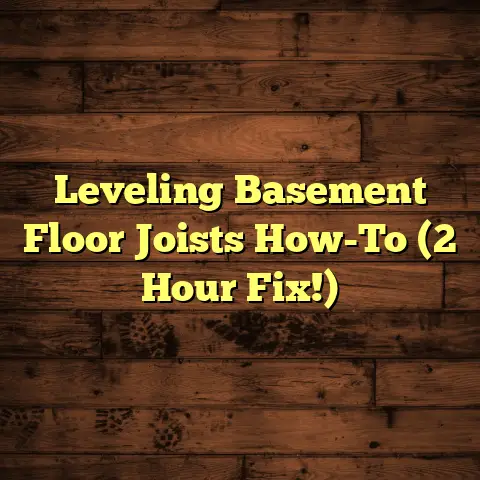Engineered Hardwood: Pros & Cons (2 Big Risks!)
I’ve seen trends come and go, but one flooring option that’s really stuck around is engineered hardwood.
It’s beautiful, versatile, and seems like a no-brainer, right? Well, hold your horses!
While engineered hardwood has a ton to offer, there are some things you need to know before you take the plunge.
I’m talking about the hidden benefits, the potential pitfalls, and, most importantly, the two big risks that could leave you with a flooring headache.
So, grab a coffee, settle in, and let’s dive
into the world of engineered hardwood.
I promise
to give you the straight goods, just like I
would with a friend.
Section 1: Hidden Benefits of Engineered Hardwood
Okay, so you see the beautiful surface, but what
else is going on with engineered hardwood?
Trust
me, there’s more than meets the eye.
1. Aesthetic Versatility
One of the first things people notice about engineered hardwood is just how darn good it looks.
I mean, it can genuinely mimic the look of solid hardwood, and even other materials like stone or tile!
This is thanks to the top layer, or veneer, which is a thin slice of real wood.
But here’s where it gets really interesting: manufacturers can apply different stains, finishes, and textures to that veneer.
Want a classic oak look? No problem. Prefer a trendy gray wash? Easy peasy.
From rustic farmhouse to sleek modern, you can find an engineered hardwood style that perfectly complements your design vision.
I’ve even seen some incredible hand-scraped and distressed engineered options that look like they’ve been around for centuries!
2. Stability in Humidity
This is a huge one, especially if you live in an area with fluctuating humidity levels.
Solid hardwood is notorious for expanding and contracting with changes in moisture, which can lead to warping, buckling, and unsightly gaps.
Engineered hardwood, on the other hand, is constructed with multiple layers of plywood or high-density fiberboard (HDF) underneath that top veneer.
These layers are bonded together in a cross- grain construction, which makes the board much more stable and resistant to moisture.
I’ve seen it firsthand: engineered hardwood holds up beautifully in basements, kitchens, and even bathrooms (with proper precautions, of course!), where solid hardwood would be a disaster waiting to happen.
3. Eco-Friendly Options
Now, I know a lot of homeowners are looking for sustainable choices these days, and engineered hardwood can definitely fit the bill.
Because only a thin layer of real wood is used on the surface, it requires less virgin timber than solid hardwood.
Plus, many manufacturers are now using
sustainably sourced wood from responsibly
managed forests.
Look for certifications
like the Forest Stewardship Council (FSC)
to ensure you’re making an eco-conscious
choice.
And get this: engineered hardwood can also reduce waste during manufacturing.
Often, the core layers are made from recycled wood fibers or other reclaimed materials.
4. Ease of Installation
Let’s be honest, nobody loves installing
flooring.
But engineered hardwood can make
the process a whole lot easier.
Many options come with click-lock systems, which allow you to simply snap the planks together without the need for nails, glue, or special tools.
I’ve seen plenty of DIYers tackle engineered hardwood installations with great success.
Of course, if you’re not comfortable with DIY, you can always hire a professional.
But even then, the installation will likely be faster and less expensive than installing solid hardwood.
5. Cost-Effectiveness
Last but not least, let’s talk about the
bottom line.
Engineered hardwood is generally
more affordable than solid hardwood.
According to HomeAdvisor, the average cost to
install engineered wood floors ranges from
$4 to $9 per square foot, including labor and
materials.
Solid hardwood, on the other hand,
typically costs $8 to $15 per square foot.
This price difference can really add up, especially if you’re flooring a large area.
You can get the look and feel of natural wood without breaking the bank.
Section 2: Pros of Engineered Hardwood
Alright, let’s break down the specific advantages of engineered hardwood in more detail.
1. Wide Range of Styles
I touched on this earlier, but it’s worth repeating: the sheer variety of styles available with engineered hardwood is mind-blowing.
Whether you’re after a traditional look, a contemporary vibe, or something totally unique, you’re bound to find an engineered hardwood option that fits the bill.
Here are just a few examples:
Oak: A classic choice that’s always in style.
Available in a range of colors and finishes, from light and airy to dark and dramatic.Hickory: Known for its durability and distinctive grain patterns.
A great option for high-traffic areas.Maple: A lighter-colored wood with a smooth, uniform grain.
Perfect for creating a bright and modern space.-
Exotic Woods: Like Brazilian cherry or tigerwood, for a more unique and luxurious look.
2. Durability and Longevity
Don’t let the “engineered” part fool you – engineered hardwood can be surprisingly durable.
The key is the wear layer, which is the top
layer of real wood.
The thicker the wear layer,
the more resistant the flooring will be to
scratches, dents, and wear and tear.
For high-traffic areas, I recommend choosing an engineered hardwood with a wear layer of at least 3mm.
With proper care and maintenance, engineered hardwood can easily last for decades.
3. Water Resistance
Okay, let’s be clear: engineered hardwood is
not waterproof.
But it is more water-resistant
than solid hardwood.
Thanks to its multi-layered construction, it’s less likely to warp or buckle when exposed to moisture.
Some manufacturers are even incorporating water-resistant cores and sealants into their engineered hardwood products.
This makes them a suitable option for kitchens, bathrooms, and other areas where spills are likely to occur – as long as you take precautions.
Clean up spills immediately, use mats in high- moisture areas, and consider sealing the edges of the flooring for added protection.
4. Ease of Maintenance
Let’s face it, nobody wants to spend hours
cleaning their floors.
Engineered hardwood
is a relatively low-maintenance option.
Regular sweeping or vacuuming is usually all that’s needed to keep it looking its best.
For deeper cleaning, use a damp mop and a pH-neutral cleaner specifically designed for engineered hardwood.
Avoid using harsh chemicals, abrasive cleaners, or excessive amounts of water, as these can damage the finish.
Section 3: Cons of Engineered Hardwood
Now for the not-so-fun part. Like any flooring option, engineered hardwood has its drawbacks.
1. Limited Refinishing Options
This is probably the biggest disadvantage of engineered hardwood compared to solid hardwood.
Because the wear layer is relatively thin, you typically can’t sand and refinish it multiple times.
In fact, some engineered hardwood floors can’t be refinished at all.
The number of times you can refinish an engineered hardwood floor depends on the thickness of the wear layer.
If the wear layer is 2mm or less, refinishing
is generally not recommended.
If it’s 3mm or
more, you may be able to refinish it once or
twice.
Before you buy, be sure to ask about the thickness of the wear layer and whether or not the flooring can be refinished.
2. Risk of Water Damage
I know I said engineered hardwood is more water- resistant than solid hardwood, but that doesn’t mean it’s immune to water damage.
If water penetrates the surface and seeps into the core layers, it can cause swelling, warping, and even mold growth.
This is especially true if the flooring is not properly sealed or if spills are left to sit for extended periods of time.
To minimize the risk of water damage, be sure to:
- Choose a water-resistant engineered hardwood product.
- Seal the edges of the flooring, especially in bathrooms and kitchens.
- Clean up spills immediately.
- Use mats in high-moisture areas.
- Avoid using excessive amounts of water when cleaning.
Section 4: 2 Big Risks of Engineered Hardwood
Okay, we’ve covered the pros and cons.
Now it’s
time to talk about the two big risks that
you absolutely need to be aware of before
buying engineered hardwood.
1. Quality Variability
This is a huge one.
The quality of engineered
hardwood can vary dramatically from one brand
to another, and even from one product line to
another within the same brand.
I’ve seen some engineered hardwood floors that are absolutely stunning and incredibly durable.
And I’ve seen others that are flimsy, poorly constructed, and prone to scratching and denting.
The key factors that affect the quality of engineered hardwood include:
- The thickness and quality of the wear layer: As I mentioned earlier, a thicker wear layer is generally more durable.
- The type and quality of the core: The core should be made from a stable and moisture-resistant material like plywood or HDF.
- The quality of the finish: A durable finish will protect the flooring from scratches, stains, and wear and tear.
- The precision of the milling: Poorly milled planks may not fit together properly, leading to gaps and uneven surfaces.
To avoid getting stuck with a low-quality product, do your research!
Read online reviews, talk to flooring professionals, and inspect samples carefully before you buy.
Don’t be afraid to ask questions about the materials, construction, and warranty.
2. Environmental Impact of Production
While I mentioned that engineered hardwood can be an eco-friendly option, it’s important to be aware of the potential environmental concerns associated with its production.
The manufacturing process of engineered hardwood can involve the use of adhesives and composite materials that may off-gas harmful chemicals, such as formaldehyde.
Formaldehyde is a known carcinogen that can cause respiratory problems and other health issues.
The good news is that many manufacturers are now using low-VOC (volatile organic compound) adhesives and formaldehyde-free materials.
Look for products that are certified by organizations like the FloorScore program or the Greenguard Environmental Institute.
These certifications indicate that the flooring has been tested and meets strict standards for indoor air quality.
Conclusion
So, there you have it – the good, the bad, and the potentially risky aspects of engineered hardwood flooring.
It’s a fantastic option that offers a blend of beauty, durability, and affordability.
But it’s not a perfect solution, and it’s crucial to be aware of its limitations and potential pitfalls.
Remember to:
- Consider the hidden benefits, like stability in humidity and eco-friendly options.
- Weigh the pros and cons carefully, taking into account your specific needs and lifestyle.
- Do your research and choose a high-quality product from a reputable manufacturer.
- Be mindful of the environmental impact of production and look for low-VOC options.
By making an informed decision, you can choose the right flooring for your home and enjoy its beauty and durability for years to come.
Happy flooring!
And feel free to reach out if
you have any questions – I’m always happy to
help.





